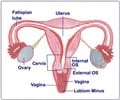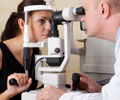There are many symptoms that are associated with the menopause and dry eye is one among them. But most of the women are unaware that the symptom is associated with the menopause or peri-menopause. Dry eye if left untreated may lead to increased risk of infection or visual impairment.
The survey, sponsored by the Society for Women’s Health Research, revealed that 62 percent of menopausal and peri-menopausal women reported that they experience dry eye symptoms. Yet, only 16 percent of the women experiencing dry eye symptoms knew that dry eye is linked to menopause. The survey, conducted in March, polled 304 women in menopause and peri-menopause, the period when the hormonal changes of menopause begin to occur.Of the 62 percent of women experiencing dry eye symptoms, less than 59 percent of these women had spoken to a doctor about their dry eye. Although the majority of women surveyed had not spoken to a physician and did not know the cause of their dry eye, nearly all knew they had a problem. About 58 percent said they had used over-the-counter eye drops to treat their dry eye symptoms.
For many women, dry eye is related to the changing hormone levels of menopause just as much as hot flashes, depression, insomnia and vaginal dryness.
Dry eye is one of the most common complaints seen by eye doctors, accounting for nearly one fourth of all office visits. Caused by insufficient tear production or excessive tear evaporation, dry eye can be a mild, episodic feeling of discomfort associated with certain circumstances, such as exposure to dry, hot or windy environments; however, it can also be a chronic medical condition that, if left untreated, may lead to increased risk of infection or visual impairment.
Chronic dry eye can have a significant and negative impact on a person’s quality of life, interfering with vision-related activities including reading, professional work, computer use and night driving. Studies confirm that many patients make significant changes to their daily lives to manage their symptoms. A recent survey showed that people with moderate to severe dry eye experience as much impact from their disease as those who suffer from moderate to severe chest pain.
The treatment options for dry eye are based not only on disease severity, but also an evaluation of the cause of the disease. It is now known that an inflammatory process in the eye is an important underlying cause of dry eye. There are three main medical treatment options: artificial tears, prescription therapies and surgery. One of the latest therapy advances is the first prescription therapy that increases tear production in patients with dry eye resulting from ocular inflammation.
Advertisement
Source: Newswise











